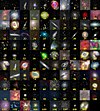NGC 2775
| Galaxie NGC 2775 | |
|---|---|
 | |
| NGC 2775 aufgenommen mithilfe des Hubble-Weltraumteleskops | |
| AladinLite | |
| Sternbild | Krebs |
| Position Äquinoktium: J2000.0, Epoche: J2000.0 | |
| Rektaszension | 09h 10m 20,12s[1] |
| Deklination | +07° 02′ 16,6″[1] |
| Erscheinungsbild | |
| Morphologischer Typ | SA(r)ab / AGN?[1] |
| Helligkeit (visuell) | 10,4 mag[2] |
| Helligkeit (B-Band) | 11,2 mag[2] |
| Winkelausdehnung | 4,3′ × 3,3′[2] |
| Positionswinkel | 155°[2] |
| Flächenhelligkeit | 13,1 mag/arcmin²[2] |
| Physikalische Daten | |
| Zugehörigkeit | NGC 2775-Gruppe LGG 169[1][3] |
| Rotverschiebung | 0.004503 ± 0.000007[1] |
| Radialgeschwindigkeit | (1350 ± 2) km/s[1] |
| Hubbledistanz H0 = 73 km/(s • Mpc) | (54 ± 4) · 106 Lj (16,7 ± 1,2) Mpc [1] |
| Durchmesser | 70.000 Lj[4] |
| Geschichte | |
| Entdeckung | William Herschel |
| Entdeckungsdatum | 19. Dezember 1783 |
| Katalogbezeichnungen | |
| NGC 2775 • UGC 4820 • PGC 25861 • CGCG 034-006 • MCG +01-24-005 • GC 1771 • H I 2 • h 564 • GALEXASC J091020.17+070216.7 • NSA 157077 • KIG 309 | |
NGC 2775 ist eine Spiralgalaxie vom Hubble-Typ Sab im Sternbild Krebs auf der Ekliptik. Sie ist schätzungsweise 54 Millionen Lichtjahre von der Milchstraße entfernt und hat einen Durchmesser von etwa 80.000 Lichtjahren. Gemeinsam mit NGC 2777 und PGC 25556 bildet sie die kleine Galaxiengruppe NGC 2775-Gruppe (LGG 169).
Die Typ-Ia-Supernova SN 1993Z wurde hier beobachtet.[5]
Das Objekt wurde am 19. Dezember 1783 von William Herschel entdeckt.[6]
- Panoramaaufnahme des 81 cm-Spiegelteleskops des Mount-Lemmon-Observatoriums
NGC 2775-Gruppe (LGG 169)
| Galaxie | Alternativname | Entfernung / Mio. Lj |
|---|---|---|
| PGC 25556 | UGC 4781 | 58 |
| NGC 2777 | PGC 25876 | 61 |
| NGC 2775 | PGC 25861 | 54 |
Literatur
- König, Michael & Binnewies, Stefan (2019): Bildatlas der Galaxien: Die Astrophysik hinter den Astrofotografien, Stuttgart: Kosmos, S. 63
Weblinks
Einzelnachweise
Auf dieser Seite verwendete Medien
Autor/Urheber: Credit Line and Copyright Adam Block/Mount Lemmon SkyCenter/University of Arizona, Lizenz: CC BY-SA 3.0 us
Picture Details:
Optics Schulman 32-inch Telescope (RC Optical Systems) Camera SBIG STL and STX CCD Camera Filters Custom Scientific and AstroDon Dates January-March 2011 Location Mount Lemmon SkyCenter Exposure LRGB = 200:50:50:50 minutes Acquisition TheSky (Software Bisque), Maxim DL/CCD (Cyanogen) Processing CCDStack (CCDWare), Maxim DL (Cyanogen), Photoshop CS5 (Adobe)Credit Line and Copyright Adam Block/Mount Lemmon SkyCenter/University of Arizona
Autor/Urheber: European Space Agency, Lizenz: CC BY 2.0
The spiral pattern shown by the galaxy in this image from the NASA/ESA Hubble Space Telescope is striking because of its delicate, feathery nature. These "flocculent" spiral arms indicate that the recent history of star formation of the galaxy, known as NGC 2775, has been relatively quiet. There is virtually no star formation in the central part of the galaxy, which is dominated by an unusually large and relatively empty galactic bulge, where all the gas was converted into stars long ago.
NGC 2275 is classified as a flocculent spiral galaxy, located 67 million light-years away in the constellation of Cancer.
Millions of bright, young, blue stars shine in the complex, feather-like spiral arms, interlaced with dark lanes of dust. Complexes of these hot, blue stars are thought to trigger star formation in nearby gas clouds. The overall feather-like spiral patterns of the arms are then formed by shearing of the gas clouds as the galaxy rotates. The spiral nature of flocculents stands in contrast to the grand design spirals, which have prominent, well defined-spiral arms.
Credits: ESA/Hubble & NASA, J. Lee and the PHANGS-HST Team; CC BY 4.0
- Acknowledgement
- Judy Schmidt (Geckzilla)
Autor/Urheber: Roberto Mura, Lizenz: CC BY-SA 3.0
Caldwell Catalogue objects.




